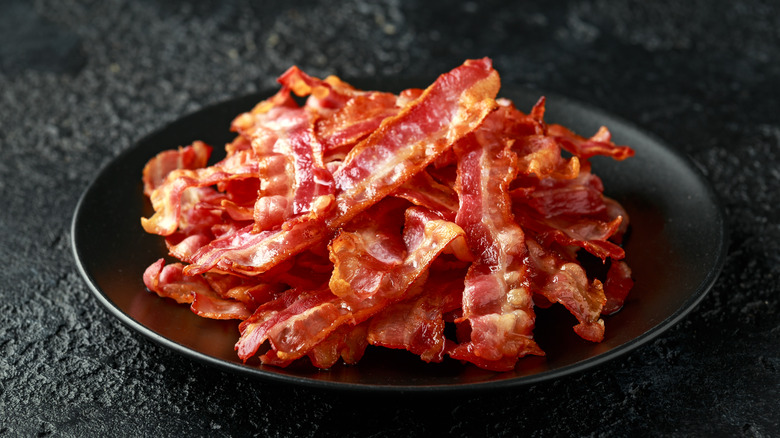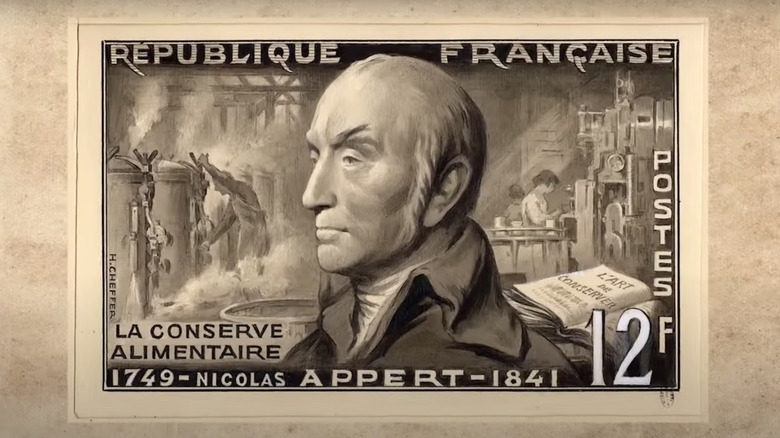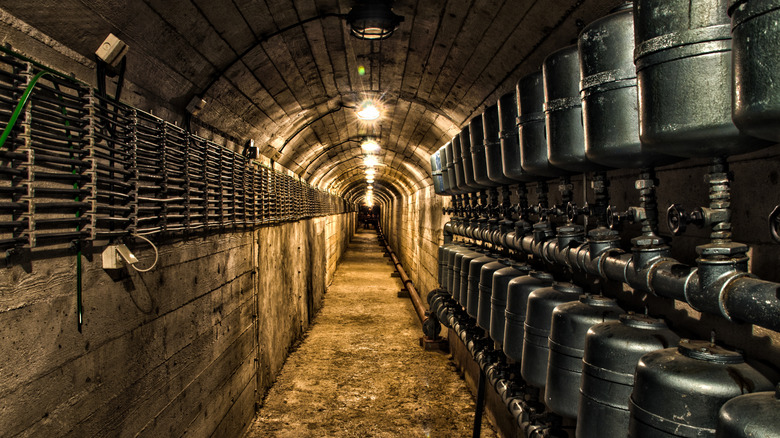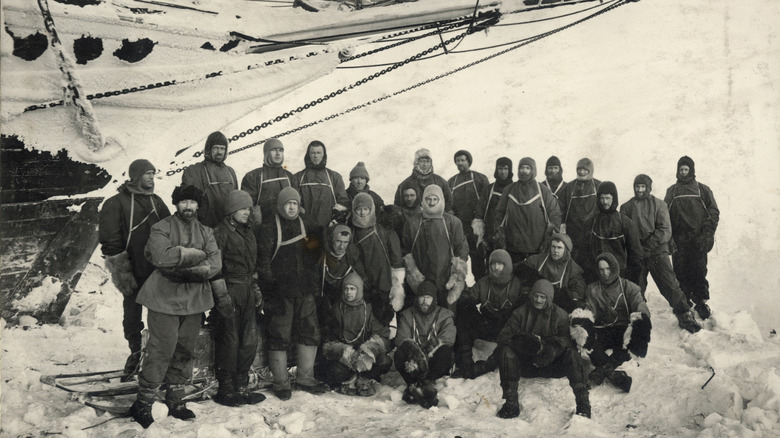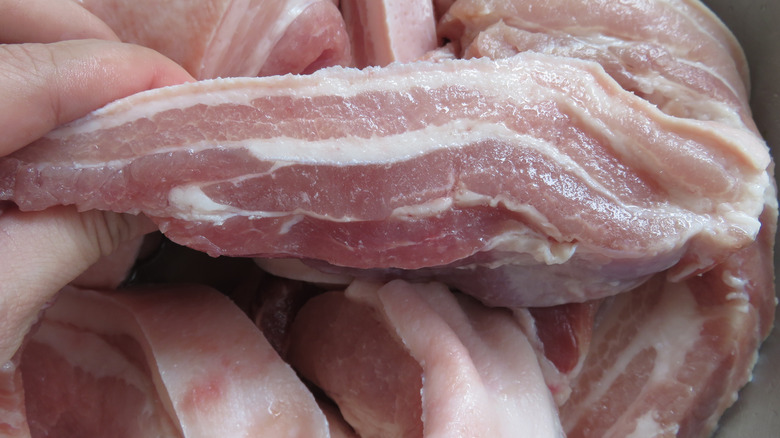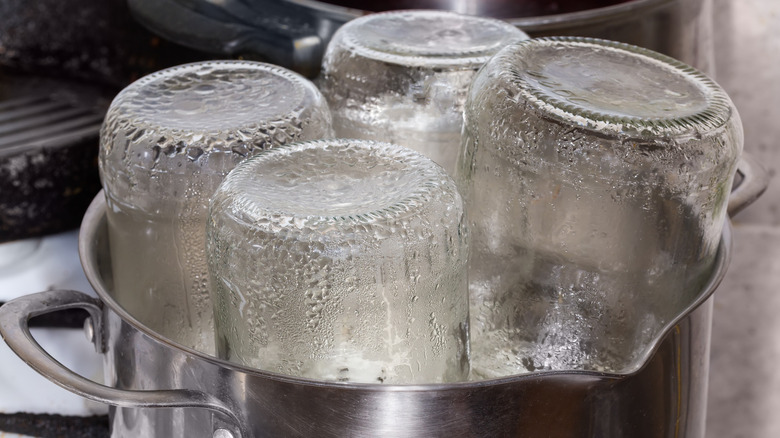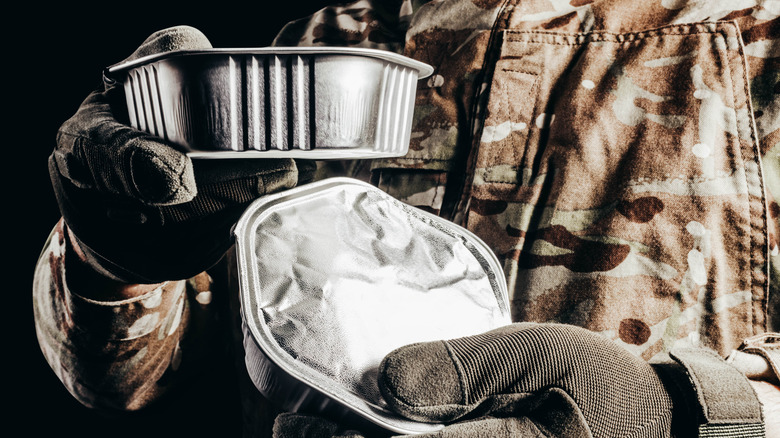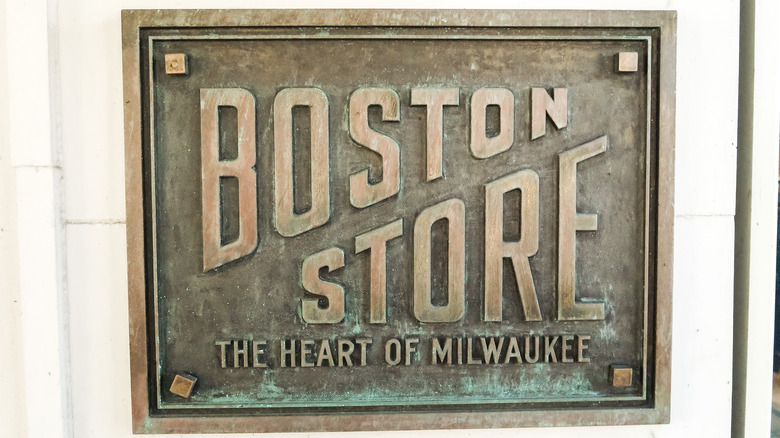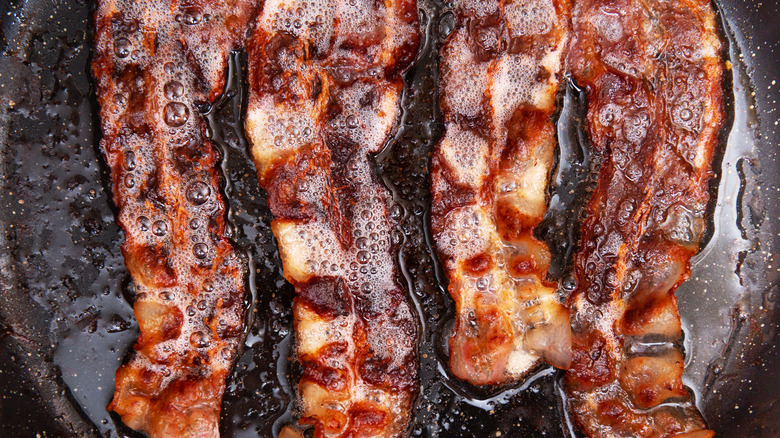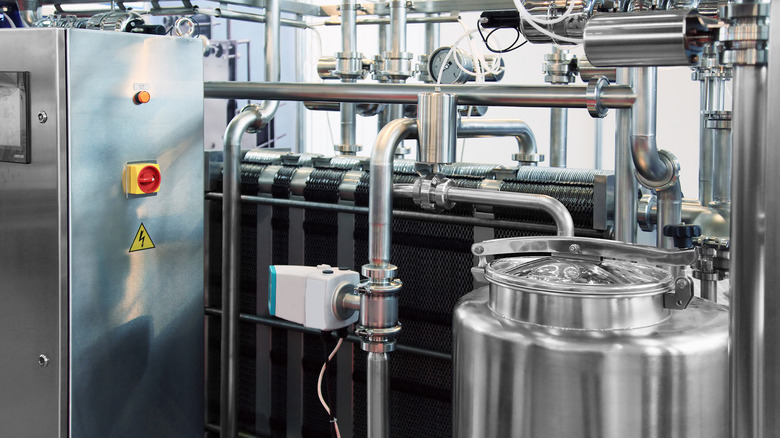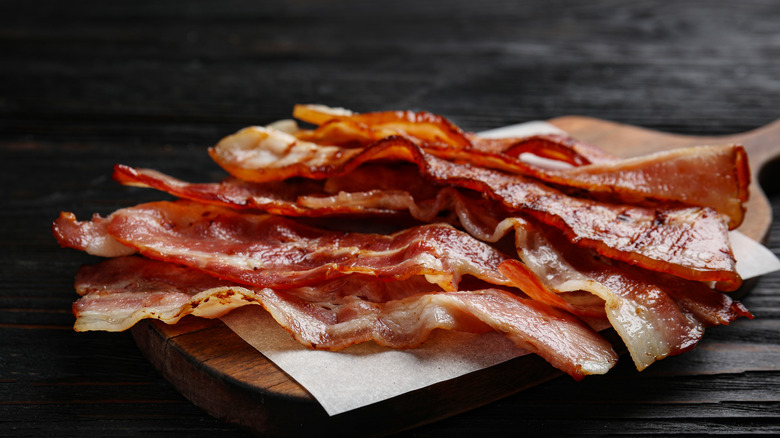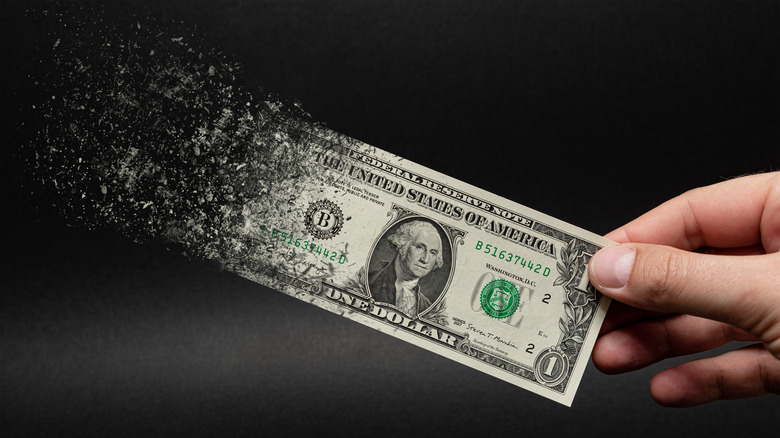The Untold Truth Of Canned Bacon
Bacon is widely praised for its delicious flavor profile: Rich and smoky with just a slight twist of sweetness, its inclusion in a dish is often touted as a surefire way to make just about anything else taste better. Among its seemingly endless uses, bacon can be added to jam spreads and sandwiches, candied for cocktail garnishes, chopped and topped on pastas and salads, wrapped around bite-sized appetizers, and even submerged into exceptionally indulgent desserts. Without a doubt, the boundless wonders of this enticing brined slab of pork belly have the world deliciously mesmerized. But among its various culinary incantations is an often unsung form you're probably not too familiar with: canned bacon.
Canned bacon is something you probably won't see on many grocery store shelves these days, but there was a time when it was much more commonplace. Throughout history and even today, canned bacon continues to evolve and serve a multitude of remarkably imperative purposes — some of which may surprise you. Here is the untold truth of canned bacon.
It all started with a competition in France
Toward the end of the 18th century, as France fought battles all around the world, the French government wanted to come up with a better way to preserve food to provide a reliable source of safe nutrition for all of its soldiers, according to the History Channel. To encourage a wave of new experimentation across the country, the government decided to hold a competition with a grand prize of 12,000 francs — the equivalent of nearly $13,000 dollars in today's currency.
A young chef named Nicolas Appert experimented for 14 years with airtight champagne bottles and wide-necked glass containers, sealing them with wax and boiling them in water, until he won the prize in 1809 and kicked off a new food industry that would eventually produce canned bacon. Appert went on to publish a book on his method, The Art of Preserving, for Several Years, all Animal and Vegetable Substances. According to Britannica, Appert used his grand prize to start up the House of Appert, the world's first commercial cannery, which stayed in business for over a century from 1812 until 1933.
An astronaut ate a canned bacon sandwich in space
European Space Agency astronaut Tim Peak pulled a smooth move as he planned his trip into space: He worked with a celebrity chef named Heston Blumenthal to develop a special menu with some of his favorite food, via Business Insider. One of Peak's requests: a bacon sandwich. As it turns out, launching bacon 250 miles above Earth to reach the International Space Station requires a lot of culinary finesse and strategic planning. According to Business Insider, space agencies put up a lot of red tape when it comes to food regulation for astronauts in order to prevent them from becoming sick. Blumenthal adapted Peak's menu to meet these specifications, but that meant the bacon sandwich had to be canned.
To further complicate matters, the canned bacon sandwich had to be heated for two hours at 140 degrees Fahrenheit in order to kill off any possible contaminants, via The Guardian. Creating a bacon sandwich that could withstand that kind of sustained temperature meant the ingredients had to be resilient: The bread was extra dense and the bacon was tough and slathered in thick butter. What was the price tag for this undertaking? According to Forbes, launching all of the food for each astronaut's meals from Cape Canaveral, including the canned bacon sandwich, cost nearly $3 million. While it's difficult to break down the exact cost for the canned bacon sandwich alone, it's fair to say that it was possibly one of the most expensive sandwiches in the world.
It's stored in bunkers for the world's most powerful people
You probably don't spend much time thinking about the secretive labyrinthian underground bunkers scattered across America (via The Guardian). And you probably spend even less time considering what their subterranean shelves are actually stocked with. As it turns out, we have good reason to believe that there are massive quantities of canned bacon buried deep underground, just waiting to be consumed by the world's most powerful people to ensure "continuity of government" in the event of a doomsday scenario, via MRE Depot.
Perusing MRE Depot's online store shows that it sells freeze-dried Canadian bacon in cans that were manufactured by a military defense contractor for purchase by the executive branch. According to MRE Depot, this usually means that its intended purpose is for storage in underground bunkers for military leaders, congressional members, and White House leadership along with other staff members in case of emergencies. Considering bacon's widespread popularity, it's no wonder that it would be top-tier survival food for the most powerful and privileged among us during an apocalypse.
It sustained a team of explorers in Antarctica
Imagine you're exploring a frigid wasteland surrounded by a churning sea of crushing ice. The temperature is so low and the wind is so strong that you can feel the bitter cold soaking into the marrow of your bones. What kind of food would you want to warm up your soul? For Ernest Shackleton, the answer was obvious: canned bacon. Ernest Shackleton was an exceptionally adventurous explorer who led a team of more than a dozen men on a gruesome and exhausting journey into Antarctica, via Britannica. Unfortunately, their ship got trapped in the ice and drifted through the glaciated waters for ten months, bumping into massive chunks of ice until it was totally ravaged. Their ship destroyed, the team then aimlessly drifted on ice floes for another five months before escaping in boats to a nearby island.
According to Slate, Shackleton journaled that "meals were the bright beacon in those cold and stormy days. The glow of warmth and comfort produced by the food and drink made optimists of us all." Among the team's packed items for sustenance in the land of endless winter: nearly 1,500 pounds of canned bacon. Other items on the list included 1,600 pounds of ham, over 1,200 pounds of sardines, and 25 cases of whisky. If you're wondering what happened to Shackleton and his team, don't worry. According to Britannica, Shackleton led four separate relief missions and rescued every last member of his crew. Amazingly, everyone survived. We'd like to think this happy ending had a little something to do with all that canned bacon.
Japan sells cans of honey mustard bacon
Most of the canned bacon you see for sale online is just plain old bacon, and while you may not be able to find much canned bacon in the grocery stores here in the United States these days, there's a treasure trove of riches awaiting for you overseas.
Japan, for instance, offers a variety of canned bacon immersed in different sauces. One of those flavors is a canned bacon in honey mustard. Canned bacon probably already sounds a bit strange to you. But canned bacon that's submerged in a honey mustard sauce? That might be too much. But before you totally write it off, think about it. The flavor combination of bacon and honey mustard is actually quite common in lots of salads, sandwiches, and pan-roasted chicken dishes. There are tons of awesome recipes that mix these flavors. Imagine nibbling on some of this Japanese honey mustard bacon and sipping on some sake. Keep an open mind and you might be surprised at how tasty this is.
Experts do not recommend canning bacon at home
In case you hadn't noticed, there's been a bit of a COVID canning craze going on, according to The Guardian. Unfortunately, if you're getting any wise ideas about trying to can your own bacon, you should think again. The National Center for Home Food Preservation says there are no safe options for canning cured, brined, or corned meats at home. That means canning bacon at home is not recommended.
While canning fresh meat can be done safely, canning cured meats is a whole different ballgame. According to Healthy Canning, people often mistakenly believe that just because bacon has nitrates in it, those nitrates will automatically protect against the growth of botulinum, a toxin generated by bacteria. Another thing that canners at home may not realize is that some of the processes being performed by commercial canneries cannot be replicated in residential kitchens, via Penn State. So if you're looking to try some canned bacon, better to play it safe and leave it to the professionals.
It was part of a combat breakfast ration during war
Canned bacon may not seem very appealing to most people today, but during the wars of the early 20th century, it was one of the heartiest forms of protein that soldiers consumed while they were overseas in combat. According to the US Department of Defense and WWII Dog Tags — a website run by collectors of WWII memorabilia — one of the combat breakfast ration sets for soldiers during war included canned bacon, biscuits, instant whole wheat cereal, coffee, tomato juice, sugar and canned milk, and cigarettes.
At first, the soldiers were given corned beef instead of canned bacon, and early on in the wars there typically wasn't too much variety in the types of meals soldiers routinely ate. However, as the war progressed, more meals were produced and flown overseas. According to the Department of Defense, the rations eventually included other dishes such as stews, spaghetti in meat sauce, pork and beans, meat and noodles, eggs and potatoes, and chopped ham.
The U.S. Army sold canned bacon at a bargain
Because it was used in rations for so many soldiers, the U.S. Army ended up having a surplus of canned bacon on hand over 100 years ago toward the end of World War I, via One Tube Radio. An old advertisement that appeared in the Milwaukee Journal promotes the sale of 1,800 cans of Army bacon at a local store. Each can weighed a whopping 12 pounds.
How much did each 12-pound can of Army bacon cost? Shockingly, for the low price of $3.66, a customer at the Boston Store in Milwaukee in 1919 could score a 12-pound can of bacon. That breaks down to about 30 cents per pound. Considering that the 9-ounce cans of bacon being sold today have over 50 slices of bacon in them, it's fair to guess that 12-pound can from over a century ago contained several hundred slices of bacon. It's wild to think that over a hundred years ago, for just over three bucks, a shopper could purchase hundreds of slices of canned Army bacon.
It's healthier than fresh bacon
First off, just to be absolutely clear: Delicious as it is, we're under no illusion that bacon is even remotely healthy you. In fact, the International Agency for Research on Cancer, a branch of the World Health Organization, has officially classified processed meat as carcinogenic. If something is carcinogenic, it means that it has the capacity to cause cancer in humans, via American Cancer Society. According to the IARC, processed meats are "transformed through salting, curing, fermentation, smoking, or other processes to enhance flavor or improve preservation." Without a doubt, bacon falls under this category.
That said, different cuts, brands, and methods of cooking and preserving bacon can result in varying levels of sodium and fat. The recommended serving size shown on most nutritional labels for bacon is three slices. Looking at the nutritional facts on Yoder's canned bacon shows that three slices of their canned bacon clocks in at 60 calories with 5 grams of fat and 190 milligrams of sodium. Compare that to the nutritional facts for three cooked strips of fresh bacon, which comes in at 120 calories, 9 grams of fat, and over 435 milligrams of sodium, via WebMD. The difference in fat and sodium may have to do with how Yoder's canned bacon is prepared and stored. According to MRE Depot, the fat and liquid is drained off of Yoder's canned bacon before it's sealed, which captures the flavor but spares you of some excess fat and sodium content.
It's heat pasteurized
One of the most common brands of canned bacon for sale is Yoder's canned bacon, which is pre-cooked and heat pasteurized before being sealed, via Be Prepared. Heat pasteurization is a "heat-treatment process that destroys pathogenic microorganisms," according to Britannica. This process typically involves heating the contents of a food until it reaches a high temperature and then holding that temperature for a set amount of time. The exact temperature and the amount of time it must be held there depends on the product, but the goal is the same: destroying pathogenic microorganisms. This ensures the contents being canned are shelf-stable and safe for consumption.
The process of heat pasteurization was developed by Louis Pasteur. When Pasteur was hired by the Napoleon III to study wine contamination, he discovered that the best way to kill off microbes was to heat the contents of the bottles to 120–140 F. Heat pasteurization is now widely used across the food industry to kill off microbes and prevent food poisoning.
It's rolled in paper
When you think of canned goods, there's a good chance that you imagine the contents of the can being drowned in a preservative goo. It's likely that when you picture canned bacon, part of the reason you're grossed out by it is because you're imagining crispy strips of bacon getting drenched and water-logged in that preservative mystery sludge. So you may be pleasantly surprised to learn that some brands of canned bacon aren't packaged that way at all.
Looking at pictures of canned bacon for sale online, it's clear that the slices of pre-cooked bacon are actually rolled up in sheets of parchment paper. According to MRE Depot, the Yoder's brand of canned bacon says that all of the bacon fat is actually drained off of the bacon prior to canning, before the bacon is rolled up in paper and sealed. The real question here is: Does knowing that most canned bacon isn't drenched in liquid make it any more appealing?
It's a luxury treat
What comes to mind when you think of a luxury treat? Maybe a nice boat of sushi at a great Japanese restaurant, or perhaps a sizzling coal-fired pizza at a fancy Italian joint. One of the last things you'd probably think about is strips of bacon sealed inside of a can, but when you take a peek at the expensive price tag, that's exactly what it is.
Shockingly, a single 9-ounce can of bacon tends to run nearly $30.00. Buying 12 cans of bacon in bulk saves a little money, costing over $200 up front, which ends up breaking down to about $20 per can. That's some pricey stuff. Makes you wonder why you wouldn't just buy fresh bacon and cook it up nice and crispy, since it would probably taste better and be easier on the wallet. But then again, fresh bacon doesn't last very long, and the whole reason canned bacon exists is to prolong its shelf-life — which can be up to ten years.
